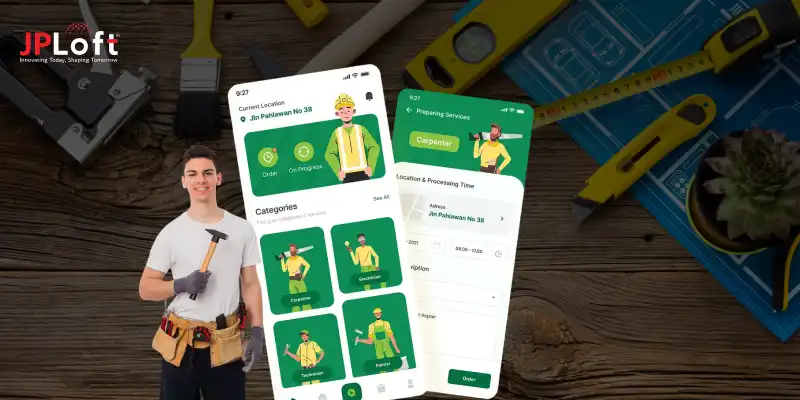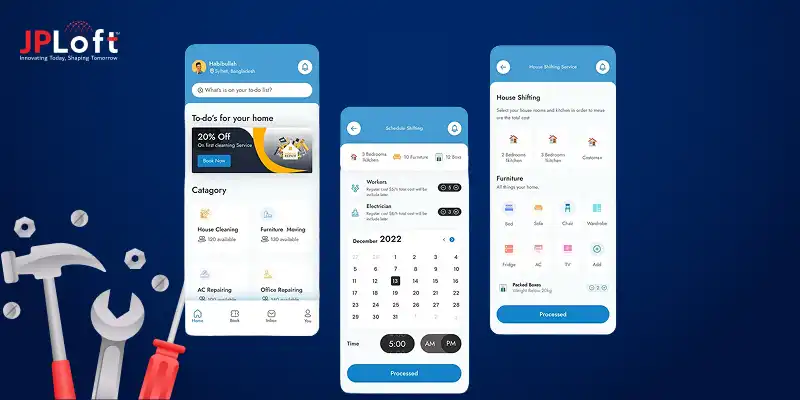"Your online presence is your 24/7 salesperson; make it work for you." – Brian Halligan
The handyman business is no longer confined to word-of-mouth or local flyers. In today’s digital era, a professional website can be the game-changer that connects your services to customers exactly when they need you.
Whether you’re an established handyman or just starting out, your website can showcase your skills, manage bookings, and position you ahead of competitors.
You might be wondering how to build a handyman website.
In short, plan your features, choose the right tech, design it well, and launch.
This blog will guide you step-by-step on how to build a handyman website that’s visually appealing, easy to navigate, and designed to convert visitors into loyal customers.
We’ll cover everything, from defining your niche, selecting a domain, and designing the layout to integrating booking systems, reviews, secure payments, and even AI-powered tools.
By the end, you’ll know exactly how to create a high-performing handyman website that boosts your visibility, attracts quality leads, and supports business growth.
Ready to turn your online presence into your most valuable asset? Let’s get started.
Key Takeaways:
A handyman website boosts local visibility, making it easier for nearby customers to find and book your services instantly.
Online booking systems reduce missed calls and streamline scheduling, increasing confirmed jobs without extra admin work.
To build a handyman website, plan features, choose a domain, design a user-friendly layout, integrate bookings, and optimize for search engines.
Showcasing reviews, certifications, and project photos builds trust and improves conversion rates from first-time visitors.
Local SEO targeting helps your site rank on Google Search and Maps, attracting high-intent leads in your service area.
Partnering with JPLoft gives you access to expert developers who deliver fast, secure, and feature-rich handyman websites built for growth.
What Does a Handyman Website Do?
A handyman website can be detailed as an online platform for showcasing services, attracting customers, and is useful for managing bookings.
It is one of the crucial platforms where businesses that offer home repair and maintenance services can showcase their skills, list their services, and help to allow customers to book appointments.
The handyman website does offer detailed service listings, customer testimonials, contact information, and a booking system that is designed to attract and convert visitors into paying customers.
Well, if you are the one looking to develop a handyman website, then evaluating the current and present stats is crucial to consider.
Hence, let's check out the following section in detail.
Latest Stats on Handyman Websites
With the help of the handyman market statistics, you will be able to learn about the effective numbers that are important for your website's survival.
Here are certain stats to check.
-
In 2025, the global handyman service is estimated to be valued at approximately USD 530.5 million. By 2035, this market is expected to grow to around USD 2340.4 million, which reflects a CAGR growth rate of 16%.
-
By the year 2033, the valuation of the handyman market is anticipated to reach USD 1,579.14 million; however, this size was within the valuation of USD 448.89 million in 2024.
-
This global handyman service market, as per Zion Market Research, was worth around USD 421.4 million in 2023, and is projected to grow to around USD 1,197.10 million by 2032, with a CAGR of roughly 12.30% between 2024 and 2032.
-
Additionally, the global handyman services market was valued at USD 342 million in 2022 and is further expected to grow at a CAGR of 13.4% during the forecasted period.
Looking forward to the handyman website development. Are you still confused about the reasons related to “why create a handyman website?”
Well, let's continue with the following section.
Why Develop a Handyman Website?
In today’s digital-first world, a professional handyman website is more than just an online listing; it’s your primary tool for attracting, converting, and retaining local customers.
When you start an online handyman business, it is essential to first ask yourself, you need to create a website or app.
Let’s learn more about the reasons to create a handyman website here.
1. 24/7 Online Presence
Your website works for you around the clock, ensuring potential customers can view your services, pricing, and availability anytime.
This means you never miss opportunities from people searching outside regular business hours. Even when you’re unavailable, your site can still capture leads through forms, chatbots, and booking tools.
Over time, this constant availability positions you as a reliable and accessible service provider.
2. Boosts Local Visibility
Most homeowners now turn to Google when searching for local service providers, making online visibility crucial.
A well-optimized handyman website can rank in Google Search, appear in Google Maps, and be listed in local business directories, helping you stand out from competitors.
With targeted local SEO, you can focus on your service area, attract nearby customers, and increase your chances of getting higher-quality, location-specific leads.
3. Builds Trust and Credibility
A professional-looking website immediately establishes trust and credibility with visitors. Including reviews, certifications, and before-and-after project photos demonstrates both expertise and reliability.
Customers are far more likely to choose a handyman whose website reflects professionalism than one without an online presence.
This credibility can also help you secure larger projects and long-term client relationships.
4. Showcases Your Services Clearly
A dedicated services section lets you outline exactly what you offer—whether it’s plumbing repairs, carpentry, painting, or electrical work, along with detailed descriptions, pricing, and package options.
This level of clarity reduces misunderstandings and minimizes repetitive questions from potential clients.
It also makes it easier for customers to compare offerings and choose you with confidence.
5. Enables Easy Booking and Inquiries
An integrated booking form or inquiry system makes scheduling quick and hassle-free for customers.
You can also include instant chat or callback request features to engage visitors on the spot.
By streamlining communication and eliminating the need for back-and-forth phone calls, you improve user experience and increase your chances of securing more confirmed bookings.
6. Supports Marketing and Promotions
Your website serves as the perfect landing space for any digital marketing campaigns, from Google Ads to Facebook promotions.
Seasonal offers, discount codes, and loyalty programs can be displayed prominently to encourage repeat business.
This flexibility allows you to adapt your marketing strategies quickly and track which campaigns deliver the best results.
7. Showcases Work Portfolio and Reviews
High-quality photos and videos of completed projects give potential customers a visual sense of your craftsmanship.
Integrating client testimonials and Google reviews adds social proof, helping sway hesitant visitors into taking action.
A strong portfolio can also differentiate you from competitors and attract clients looking for specific styles or expertise.
8. AI-Driven Personalization and Efficiency
By incorporating AI chatbots, your site can instantly respond to FAQs, provide quotes, and recommend services tailored to customer needs.
AI tools can also automate lead tracking, send appointment reminders, and follow up with past clients, reducing administrative work.
This allows you to focus more on delivering services while keeping customer interactions timely and professional.
9. Scale Your Business Beyond Word-of-Mouth
A website allows you to expand your reach far beyond personal referrals.
By targeting specific neighborhoods, cities, or commercial markets with landing pages, you can attract both residential and business clients.
Over time, this broader reach can lead to new partnerships, more service requests, and even opportunities to expand into new locations.
After learning about the reasons, let’s concentrate on the diversified types of features that you should include while creating it.
The following section details it all.
Must-Have Features for a Handyman Website
When you start a website, it is crucial to look for the comparative features that can be useful to sustain it in the long run.
Features are the components that help in sustaining a website and creating differentiation among competitors.
Here is the list of the features to look for.
-
Service Listings with Descriptions
Display each service you offer with short explanations, pricing, or package details. Helps customers quickly understand your expertise and choose the right service.
-
Online Booking System
Allow customers to schedule services instantly through a simple, mobile-friendly booking form. Reduces back-and-forth communication and increases confirmed jobs.
-
Contact and Inquiry Form
Make it easy for visitors to reach you with quick forms for questions, quotes, or call-back requests. Improves lead collection and ensures no potential customer is missed.
-
Photo & Video Gallery
Showcase before-and-after images or videos of completed projects to build trust and credibility. Visual proof of quality work often converts visitors into paying customers.
-
Customer Reviews & Testimonials
Display real feedback from past clients to boost confidence in your services. Positive reviews also improve your Google rankings and online reputation.
-
Live Chat or Chatbot Support
Provide instant answers to customer queries, appointment requests, or service recommendations. Increases engagement and helps capture leads outside working hours.
-
Location Map & Service Area Info
Use Google Maps to show your exact service area and make it easier for local customers to find you. Helps attract more relevant leads within your preferred working zone.
-
About & Credentials Section
Share your experience, certifications, and company story to build a personal connection. Adds credibility and shows customers they are hiring a trusted professional.
-
Mobile-Friendly Responsive Design
Ensure your website works seamlessly on all devices, as most customers search from their phones. Improves user experience and supports higher search engine rankings.
-
Special Offers & Promotions
Highlight seasonal discounts or bundled service deals to attract more bookings. Encourages repeat business and customer loyalty.
-
Blog or Tips Section
Publish home maintenance tips, DIY guides, and seasonal checklists to improve SEO and authority. Keeps your site fresh and positions you as an expert.
-
Secure Payment Gateway
Enable safe online payments for bookings and invoices, adding convenience for customers. Builds trust and makes transactions faster and hassle-free.
Till now, we have discussed concepts of a handyman website, statistics, and related features. Now, let’s evaluate the crucial steps to make a handyman website in the following section.
Steps to Build a Handyman Website
How to create a handyman website?
Well, to build an effective and leading handyman website, you require a series of steps that will begin with market study and end with website launch.
Let’s learn all in the following series of steps.
Step 1: Market Study
Learning about the market can be useful in standing out from the competitors and then identifying the potential audiences who are your core customers.
Let’s know it more comprehensively.
A) Understanding the Local Area Dynamics
It's significant to research the local area dynamics, analysing the demands for different services to assist you in targeting profitable niches.
For instance, if you live in a rural area, offering general handyman services might be more effective, since there may not be other professionals around for miles. For urban areas, where competition is higher, picking a niche can help you stand out and bring in clients.
Under this, you will be able to learn about the demographics, community value, and culture, along with assessing the economic factors.
B) Define the Niche
You should know and learn about your market very well. Here, it's essential to evaluate whether you want to invest in the commercial Vs. Residential jobs, while entering the handyman industry.
It is important to narrow down the focus, which can further help you to achieve greater success. You should specialize in a specific area of handyman services, such as home repairs, renovations, plumbing, and HVAC.
This will be an effective way for segmenting the audiences and then identifying the core possibilities to rank in a diversified number of businesses.
Step 2: Select a Domain Name and Hosting
Now, it comes to selecting the domain name, which should be unique and match the frequency of your business. Pick a reliable hosting provider to ensure your site is fast and always online.
Here is the list that you should follow to help select the domain name and a hosting partner.
A) Choosing a Domain Name
-
Keep it short, simple, and easy to remember.
-
Include relevant keywords (e.g., “handyman,” “repairs,” “services”) for better SEO.
-
Use your location in the name if targeting a specific area (e.g., DenverHandyman.com).
-
Avoid numbers, hyphens, or complex spellings.
-
Go for a .com extension for credibility (or .co/.net if .com is unavailable).
-
Check availability on social media platforms to keep branding consistent.
-
Make sure it’s unique and not infringing on another business’s trademark.
B) Choosing a Hosting Partner
-
Ensure fast loading speeds for better user experience and SEO.
-
Look for 99.9% uptime reliability so your site is always accessible.
-
Choose scalable hosting plans to handle future traffic growth.
-
Prioritize strong security features (SSL, DDoS protection, backups).
-
Confirm they have 24/7 customer support via chat, email, or phone.
-
Select a hosting provider with data centers close to your target audience for faster loading.
-
Check if they offer easy WordPress or CMS integration.
-
Consider pricing, but don’t compromise on performance and reliability.
When creating a handyman website, choose a domain name that’s short, easy to remember, and includes your service type or location for better local SEO. For a hosting partner, prioritize fast loading speeds, high uptime, strong security, and reliable support to ensure your site stays accessible and trusted by customers.
Step 3: Choose a Suitable Website Builder
Now, it's time to select a suitable website builder that can help in building an effective and leading website.
But the question that lies here is “ how to select an optimized and better website builder for your dream website.
Here is a list to consider before you hire dedicated developers for your website and choose a suitable website builder.
-
Ease of Use: Pick a builder with a drag-and-drop editor so you can easily update content without coding skills.
-
Mobile Responsiveness: Make sure it automatically adapts to mobile screens, as most visitors will use smartphones.
-
Customization Options: Choose handyman-friendly templates you can personalize with your branding and colors.
-
Built-in SEO Features: Look for options to add meta tags, alt text, and local SEO settings for better search rankings.
-
Booking and Contact Tools: Ensure it supports online bookings, quote requests, and live chat to capture leads.
-
Portfolio and Media Support: The platform should let you showcase before-and-after photos and project videos.
-
Speed and Performance: Select a builder known for fast-loading websites to keep visitors engaged.
-
Security Features: SSL, backups, and hack protection are essential for customer trust and safety.
-
Scalability: Make sure it allows you to add more services, pages, or even eCommerce features as you grow.
-
Cost and Value: Compare features and pricing to ensure you get the best return for your investment.
-
Customer Support: Go for a provider with reliable 24/7 support via chat, email, or phone.
-
Integration Options: Check if it connects with tools like Google Analytics, CRM systems, and payment gateways.
In addition to this, consider the website template, home page, Logo, and contact page.
A) Website Template
Start with a ready-made handyman website template from platforms like WordPress, Wix, or Squarespace. It saves design time and already includes layouts suited for service-based businesses.
B) Home Page
Design a clean, inviting homepage that highlights your services, service area, and a strong call-to-action for booking or contacting you. Make it visually appealing with high-quality images.
C) Logo
Create a simple, memorable logo that reflects your handyman brand. Use consistent colors and styles across the website for a professional look.
D) Contact Page
Include a clear contact form, phone number, email, and Google Map location so customers can reach you easily. Adding a quick inquiry form helps capture leads instantly.
Step 4: Design the Website
Designing isn’t limited to selecting the color, theme, and font irrespective of it is more than that.
Let’s learn more about the same in the following design practices.
A) Choose a Clean, Professional Layout
Pick a design that looks modern, uncluttered, and easy to navigate. Use consistent colors, fonts, and spacing to make the site look polished and trustworthy.
B) Prioritize Mobile-Friendly Design
Most customers will visit from their phones, so ensure your site adapts perfectly to all screen sizes. Mobile-friendly design also helps improve search engine rankings.
C) Highlight Key Information Above the Fold
Place your most important details- services, contact info, and a call-to-action- at the top of the homepage. This ensures visitors see them without scrolling.
Step 5: Showcase Your Handyman Services Clearly
It is essential to showcase the entire range of services here. This will help you attract and engage the audience in the long run.
Here is the list that you can follow when it comes to displaying the handyman services, while creating a handyman website.
Let’s follow it.
A) List Services with Clear Titles and Descriptions
Use straightforward service names like Plumbing Repairs, Carpentry Work, or Electrical Fixes so customers instantly understand what you offer. Add a short, plain-language description for each to explain the scope of work.
B) Use Visuals to Enhance Understanding
Add high-quality images, before-and-after project photos, or icons next to each service. Visual elements help customers connect with your work and build trust in your skills.
C) Organize Services for Easy Navigation
Group related services into categories, such as Indoor Repairs or Outdoor Projects, so visitors can quickly find what they’re looking for. This improves user experience and helps convert more leads.
Step 6: Create Optimized Content
When you develop a handyman website, it is important to learn that you should create optimized content. This should be detailed and effective enough to enhance the user’s experience with your website.
A) Use Local SEO Keywords Naturally
Incorporate location-based phrases like handyman services in [City] or [City] home repair within your service descriptions, headings, and meta tags. This helps search engines connect you with customers in your target area.
B) Write Clear and Helpful Service Descriptions
Keep your copy simple, direct, and focused on what the customer gains. Mention the problems you solve, how you work, and why your service is reliable. Avoid jargon so that anyone can understand.
C) Add Blog Content to Attract Visitors
Publish posts like Home Maintenance Tips or Seasonal Repair Checklists to bring in traffic and showcase your expertise. Fresh, relevant content also signals to Google that your site is active and valuable.
Step 7: Develop the Core Functionalities
Creating the core handyman website requires backend practices that should be supportive of delivering the leading handyman website.
Here is the list of core functionalities that you should consider in detail.
A) Core Service & Booking Features
Include a well-structured service catalog, pricing or instant quotes, and a robust booking engine with availability checks. Add customer accounts, technician profiles, and integrated payment gateways for smooth transactions.
B) User Experience & Engagement Tools
Design mobile-friendly pages with essential content: Home, Services, About, Gallery, and Contact. Integrate live chat, quote forms, reviews, ratings, and visual galleries to build trust and improve conversions.
C) SEO, Marketing & Analytics
Optimize for local SEO with location-based pages, schema markup, and consistent NAP details. Add a blog for content marketing, track performance with analytics, and experiment with A/B testing for CTAs and forms.
D) Security, Performance & Scalability
Use HTTPS, backups, and security tools to protect customer data. Ensure fast load times, image optimization, and caching for performance. Plan for future scalability with multi-location or multi-language support and optional AI features.
Here is the detailed table of tech stack that you can use while building a handyman website.
|
Technical Aspect |
Core Technologies / Tools |
|
Frontend Development |
HTML5, CSS3, JavaScript, React.js / Vue.js |
|
Backend Development |
Node.js, Laravel (PHP), Django (Python) |
|
Database |
MySQL, PostgreSQL, MongoDB |
|
Content Management System |
WordPress, Drupal, Custom CMS |
|
Hosting & Deployment |
AWS, DigitalOcean, Bluehost, SiteGround |
|
Booking & Scheduling |
Custom APIs, Calendly API, Amelia/BookingPress (WordPress) |
|
Payment Integration |
Stripe, PayPal, Razorpay |
|
SEO & Analytics |
Google Analytics, Google Search Console, RankMath / Yoast SEO |
|
Security |
SSL Certificates, Cloudflare, reCAPTCHA |
|
Performance Optimization |
CDN (Cloudflare, AWS CloudFront), Image Compression (WebP) |
|
Maps & Location Services |
Google Maps API, Mapbox |
|
AI & Chatbot Integration |
Dialogflow, OpenAI API, Tidio/LiveChat |
Step 8: Testing the Website
Now, it's time to perform adequate testing that will help in identifying the potential bugs, and then reducing them via effective tools and techniques.
Here’s more to view.
A) Functional Testing
Check that all features, booking forms, payment gateways, contact forms, and navigation work as intended. Test on multiple browsers and devices.
Tools: Selenium, TestComplete, BrowserStack.
B) Performance & Speed Testing
Ensure the website loads quickly and handles multiple users without lag. Optimize images, scripts, and server response times.
Tools: Google PageSpeed Insights, GTmetrix, WebPageTest.
C) Security & Mobile Responsiveness Testing
Verify SSL setup, secure payment processing, and protection against common threats. Also, test mobile usability for different screen sizes.
Tools: OWASP ZAP, Google Mobile-Friendly Test, SSL Labs.
Step 9: Monitor, Launch, and Maintain
You cannot succeed until you monitor the website closely. It is one of the crucial parameters to observe and consider when it comes to creating a handyman website.
Here is the process that you need to follow while monitoring, launching, and maintaining the handyman website.
A) Official Launch and Promotion
Go live with your handyman website and promote it through social media, Google Business Profile, and local marketing to attract your first wave of customers.
B) Monitor Website Performance
Track visitor data, booking trends, and page performance using analytics tools to identify what’s working and where improvements are needed.
C) Maintain and Update Regularly
Keep your site fresh by updating service details, adding new content, fixing bugs, and maintaining security to ensure smooth, long-term operation.
You can consider connecting with the effective who can help you streamline the optimization process smoothly.
Following these steps to create a handyman website, you can build your dream handyman website.
Well, with this growing trend of AI, you can consider implementing and adopting AI for creating the handyman website.
Hence, let’s learn it in the following section.
AI’s Role in Handyman Websites
When you begin to develop a handyman website, one of the crucial aspects that you might come across is the implementation of AI in building it. Right?
AI can transform a handyman website from a simple online presence into a smart, customer-focused platform. With the right tools, you can automate tasks, personalize user experiences, and improve operational efficiency.
► AI Chatbots for Instant Support
AI-powered chatbots can answer common customer questions, provide instant quotes, and guide visitors to the right services, reducing response time and increasing conversions.
► Smart Scheduling and Booking
AI can analyze your availability, travel time, and job complexity to suggest the most efficient booking slots. This helps avoid overlaps and maximizes daily jobs.
► Predictive Maintenance Recommendations
By analyzing past service requests, AI can suggest seasonal or recurring maintenance tasks to customers, encouraging repeat business.
► AI-Powered Marketing
AI tools can study customer behavior and generate targeted offers, emails, or ads, making marketing campaigns more effective.
► Voice Search Optimization
As more customers use voice assistants, AI-driven SEO strategies can help your site appear for queries like “find a handyman near me” or “book plumbing repair now.”
Leveraging AI in handyman platform, the capabilities extend beyond websites, enabling seamless service delivery, smarter scheduling, and personalized customer interactions directly through mobile platforms.
Well, let’s evaluate the real-case scenarios of top handyman websites in the following section.
Top Handyman Websites: Real Case Studies
Looking at successful handyman websites can give you practical ideas for design, features, and customer engagement strategies.
1. Mr. Handyman
A clean, mobile-friendly site with clear service categories, online booking, and strong local SEO that dominates Google search results in multiple cities. Their consistent branding and trust badges help reinforce credibility and customer confidence.
2. Ace Handyman Services
Features a modern layout, instant quote requests, and detailed service pages with customer testimonials, boosting trust and conversions. Their easy navigation and responsive design make it simple for users to find and book services quickly.
3. Handy
An app-first handyman platform with seamless booking, transparent pricing, and AI-based job matching to connect customers with the right professionals, similar to what you’d expect when exploring the cost to build a platform like Handy.
It also offers flexible scheduling options, appealing to busy customers who need same-day or next-day service.
4. TaskRabbit
While not purely handyman-focused, it excels in user experience, something to consider when evaluating the cost to develop a platform like TaskRabbit.
It offers service filtering, verified profiles, and secure in-platform payments, while its review system and skill-based filters make it easy for users to find exactly the help they need.
Are you creating your own handyman website?
Well, if yes, then let’s learn more about the same in the next section.
Cost to Develop a Handyman Website
What’s the cost to create a handyman website?
The cost to develop a handyman website can vary from $20,000 to $150,000. Here, there are different factors impacting this cost, which include the complexity of features, the design of the website, and much more.
Want to learn about the factors impacting this cost? Well, let's learn it in the following section.
Main Factors Affecting Website Development Cost
What are the main factors impacting the overall cost to build a handyman website?
Let’s learn them all in this section, via a table.
Initial development cost split (total budget: $20,000–$150,000):
|
Factor |
What it covers |
Share |
Cost @ $20k |
Cost @ $150k |
|
Responsive layout, brand styling, visuals |
12% |
$2,400 |
$18,000 |
|
|
Core features & logic |
Services, booking, payments, accounts, reviews |
45% |
$9,000 |
$67,500 |
|
CMS or custom setup, environments |
6% |
$1,200 |
$9,000 |
|
|
Third-party integrations |
Maps, CRM, chat, analytics |
7% |
$1,400 |
$10,500 |
|
Content & SEO setup |
Copy, images, on-page SEO, schema |
6% |
$1,200 |
$9,000 |
|
SSL, backups, access control |
4% |
$800 |
$6,000 |
|
|
Testing & QA |
Cross-device/browser tests, fixes |
8% |
$1,600 |
$12,000 |
|
PM & documentation |
Planning, sprints, specs, handover |
12% |
$2,400 |
$18,000 |
Note: Post-launch maintenance is typically $2,000–$15,000/year and sits outside the initial build.
Team & location impact (rate multiplier on the same scope):
|
Team model |
Typical blended rate |
Impact on total |
Notes |
|
US/UK product studio |
~$90–$150/hr |
+35% to +60% vs global avg |
Highest velocity and proximity |
|
Eastern Europe |
~$35–$65/hr |
Baseline |
Strong engineering value |
|
India/SEA |
~$25–$50/hr |
−15% to −30% vs global avg |
Best for cost efficiency |
|
Hybrid (lead onshore + offshore dev) |
Mixed |
Balanced |
Cost control with senior oversight |
Learning about the cost to build a handyman website can help you in evaluating the total investments that you require to consider while investing.
However, let’s figure out the ways to make money after creating the handyman website in the following section.
Ways to Earn from a Handyman Website
We have discussed the points of investments and how to invest to make a handyman website, but the most significant question to work on here is how handyman websites earn money.
Let’s figure it out in this section.
1. Direct Service Bookings
Offer core handyman services like plumbing, carpentry, and electrical repairs directly through your website with an integrated booking and payment system.
2. Subscription or Maintenance Plans
Sell recurring maintenance packages for seasonal or annual home check-ups, providing steady, predictable income. You can offer monthly and annual subscription plans when it comes to creating a handyman website.
3. Emergency Service Premiums
Charge higher rates for urgent, same-day, or after-hours service requests booked through your site.
4. Affiliate Marketing for Tools & Supplies
Promote partner brands or tools you use and earn commissions when customers purchase via affiliate links.
5. Lead Generation for Other Contractors
Refer jobs outside your expertise to partner service providers and earn referral fees.
6. Online DIY Courses or Guides
Create and sell video tutorials or downloadable guides for simple home repairs, appealing to the DIY audience.
Are you the one searching for a qualified team of developers to build your website? Then the following section is for you.
Why Partner with JPLoft?
JPLoft, as an expert handyman app development company, is designed to help you take your business online with ease.
From creating a professional website to building feature-rich mobile apps, they ensure your platform is fast, secure, and user-friendly.
Our team understands the needs of service-based businesses and delivers solutions that include booking systems, secure payments, and customer management tools.
With a focus on performance, scalability, and modern design, JPLoft helps you stand out in a competitive market. Partnering with them means getting a reliable tech partner committed to your long-term success and growth.
Conclusion
Building a handyman website is a strategic move to attract more customers, showcase your expertise, and strengthen your brand.
The process involves planning your services, selecting the right domain and hosting, choosing a suitable website builder, designing a user-friendly layout, adding essential features like booking systems and customer reviews, creating optimized content, and testing for performance and security before launch.
Incorporating AI can further enhance user engagement and streamline operations. By following these steps, you can create a professional platform that drives leads, builds trust, and supports long-term business growth.
FAQs
Plan your services, choose a domain, select a builder, design pages, add features, test, and launch.A professional developer can streamline the process and ensure a high-quality build.
$20,000 to $150,000, depending on features and complexity. The cost varies based on design, functionality, and the development team’s location.
No, you can use website builders or hire developers. Hiring experts ensures better design, security, and long-term scalability.
Booking, service listings, reviews, contact forms, and payment gateway. Adding a photo gallery and blog can further boost credibility and SEO.
Yes, AI can automate booking, support, and marketing. It can also personalize user experiences to increase engagement and retention.
Use local SEO, promotions, and easy online booking forms. Displaying positive customer reviews can significantly improve conversion rates.













Share this blog